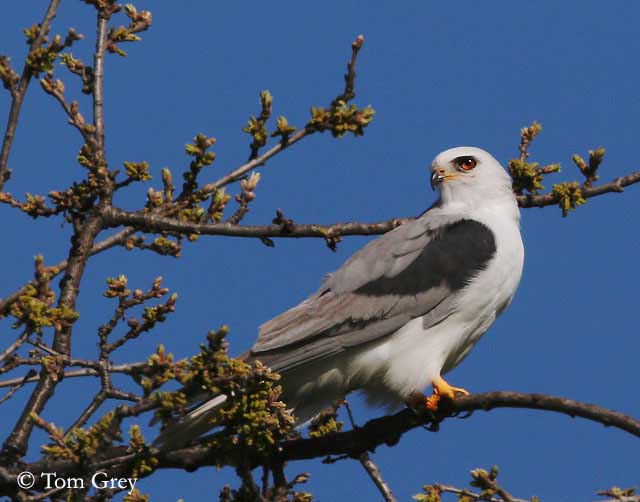
White-tailed Kite
Elanus leucurus
Accipitriforme Order – Accipitridae Family
BIOMETRICS :
Length: 38-43 cm
Wingspan: 102-107 cm
Weight: 300-360 g
LONGEVITY : up to 6 years
DESCRIPTION:
White-tailed Kite adult has pale grey upperparts, black shoulders and primaries. Underparts are white. Square tail is short, white and pale grey. Long, pointed wings are pale grey and white below, and we can se black patches at bend.
Head is entirely white. Hooked bill is black with yellow cere. Eyes are red with white eye ring. Legs and talons are yellow.
Both sexes are similar.

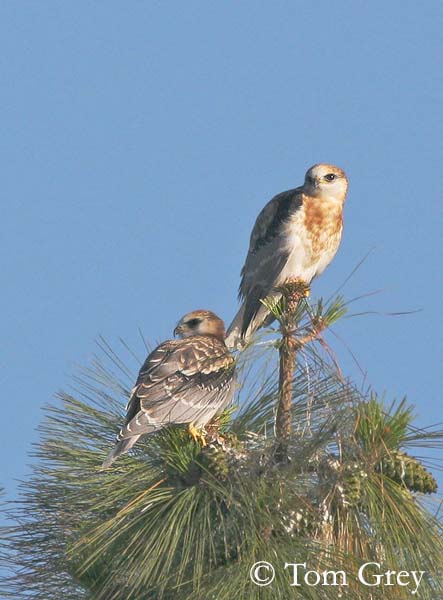
Juvenile has white underparts and head, streaked with rufous, becoming duller very soon. Wings are dark and upperparts are grey-brown.
We have two subspecies:
Elanus leucurus leucurus of South America
Elanus leucurus majusculus, larger, of North America.
VOICE: SOUNDS BY XENO-CANTO
White-tailed Kite utters whistles, such as “keep-keep-keep” at nest, and a yelp. Alarm call is a double whistle “plee-wit, plee-wit”. When it attacks other birds, it gives a series of shrill, chattering and whistles.
HABITAT:
White-tailed Kite lives in grasslands, farmlands, savannahs, marshes, open woodlands and partially cleared lands.
RANGE:
White-tailed Kite is resident from the West Coast and Gulf Coast of United States into Central America and eastern South America.
BEHAVIOUR:
White-tailed Kite searches for prey while it is soaring or even performing hovering flights. When prey is located, it swoops down onto it. This bird of prey has the same hunting strategy as the American Kestrel.
White-tailed Kite regurgitates pellets after eating, with fur, bones and feathers, compacted into little pellets.
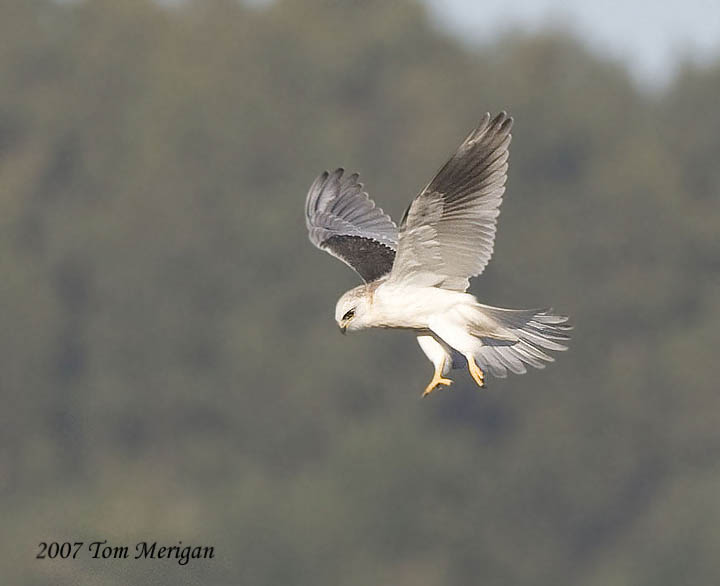
After breeding season, White-tailed Kite roosts in trees, in large flocks of up to 120 birds. They hunt from this place. This species is non-migratory. They may perform some dispersion if preys are scarce.
During breeding season, building of the nest is a part of the courtship and territorial display. When the territory is established, the male flies from tree to tree, sometimes with a twig in the bill. Female may also perform the same display.
Another courtship ritual between mates consists in the aerial method used to transfer food from male to female. Female flies under the male, and turns down to seize the prey with its talons, while both often utter some “eegrack” sounds.
Some displays begin at roost places, with some chases and dives between two birds. White-tailed Kites are monogamous.
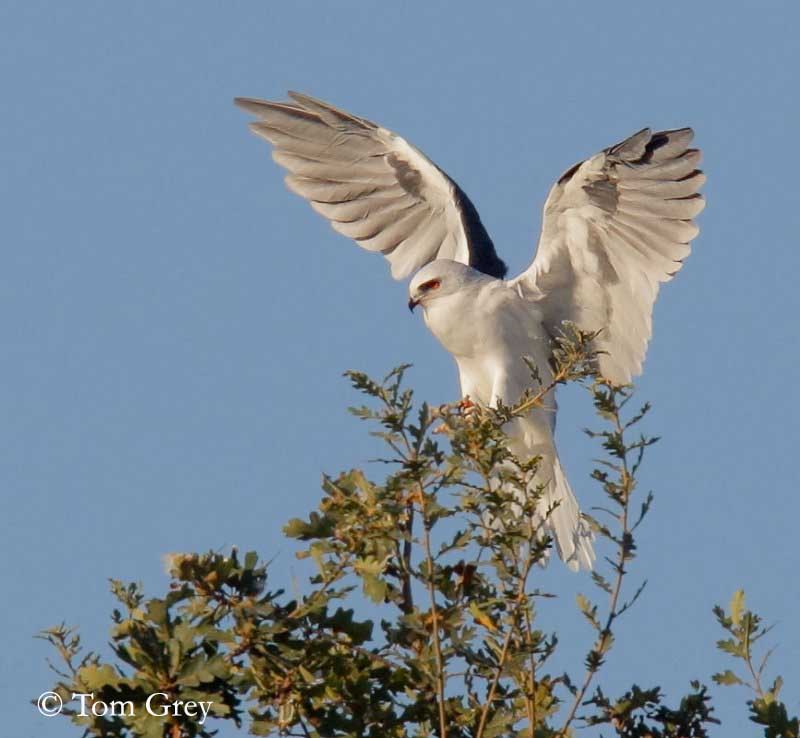
When the parents feed the young, the male hunts and brings food to the female, transferring the prey to female in midair, as during courtship display.
White-tailed Kite performs some displays to defend its territory, including chasing, circling dives above the intruder, bobbing tail up and down, fluttering in trees or bushes within the territory, but sometimes, defensive actions can result in physical contact, with the wing of an opponent hold in the beak of the other kite. The intruder is unable to fly and falls downwards. They separate at about half distance to the earth. They may descend to almost ground level.
FLIGHT:
White-tailed Kite is the only North American kite able to hover while hunting. It lets tail and legs dangle in the air, while it surveys the ground, searching for prey. It may glide for very long distance, and soar to very impressive heights.

REPRODUCTION:
White-tailed Kite nests at tree tops. Both male and female build a small loose nest made with thin twigs, at about 20 to 60 feet high, in an isolated tree. The same nest is reused year after year. Male brings nest materials and female works into the nest. Nest is lined with grasses, weed stems and rootlets.
Female lays 3 to 5 cream or pale buff eggs, marked with darker spots. Incubation lasts about 25 to 28 days, by female, but she is fed by the male. Altricial chicks are covered with yellowish down, turning greyish at about 7 days.
Male hunts and brings food to female. When the young are older, and may be left at nest, female hunts with the male. At this time, young have open eyes and take pieces of food from the female’s bill.
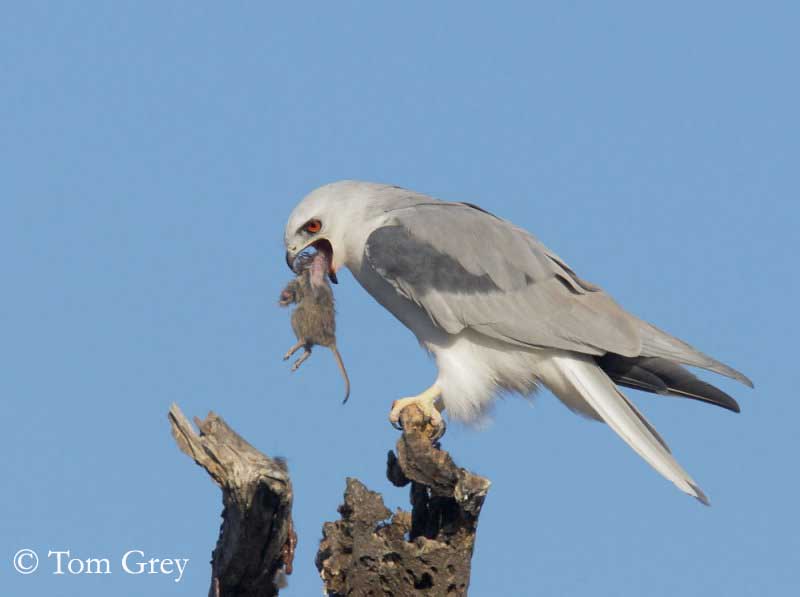
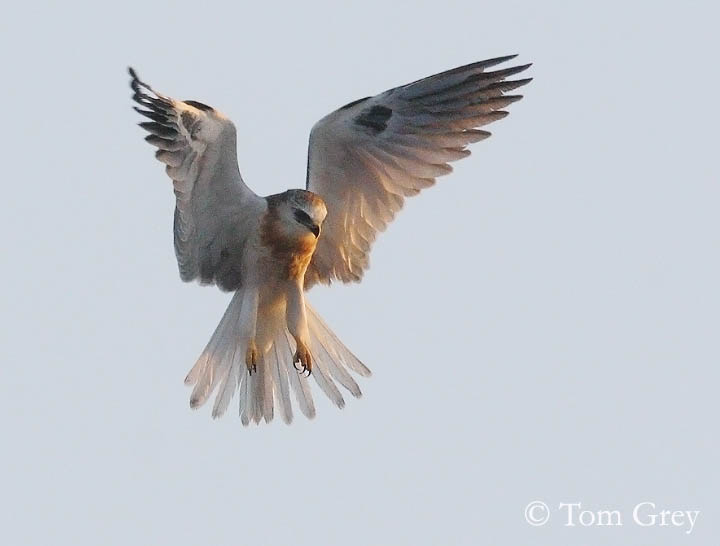
When they are 30 to 40 days old, they are able to tear up prey themselves, and they begin to fly. They need one month more before to start catching their own prey.
One week later, male demonstrates hovering flight to the young, performing hover and drop hunt sequence in front of perched young, and then, young birds participate to learn the hovering hunting technique.
This species produces one brood per year, sometimes two.
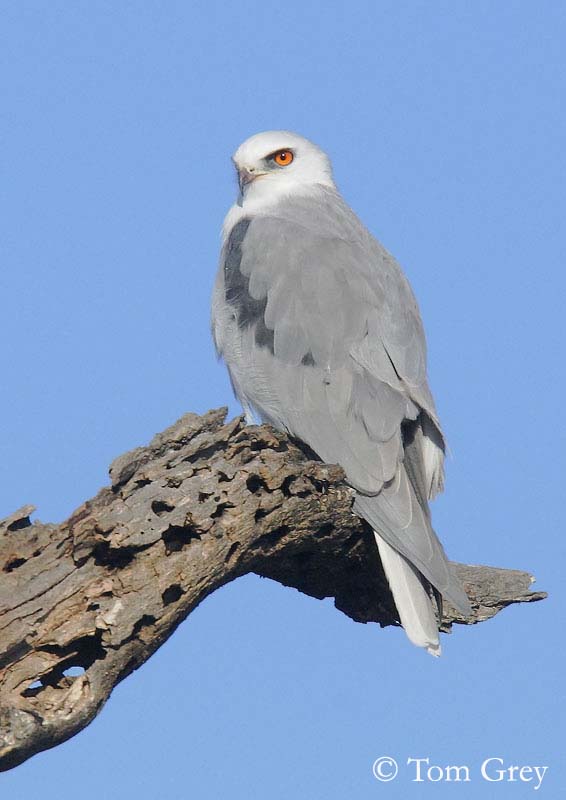
DIET:
White-tailed Kite feeds mainly on rodents (voles, mice, ground squirrels of about 70 g of weight) small birds, small snakes, lizards, frogs, grasshoppers and beetles.
PROTECTION / THREATS / STATUS:
White-tailed Kite is threatened by direct human persecution, use of pesticides and mainly by habitat loss. These raptors were shot by farmers to protect their chicken.
However, this species has made a very good increase in California and Texas, and becomes common in suitable habitats.
Fr: Elanion à queue blanche
All : Weisschwanzaar
Esp : Elanio Maromero
Ital : Nibbio codabianca
Nd : Amerikaanse Grijze Wouw
Sd : Vitstjärtad glada
Photographs by Tom Merigan
His website:
Tom Meriganís Photo Galleries
Photographs by Tom Grey
His website :
Tom Grey's Bird Pictures
Text by Nicole Bouglouan
Sources :
HANDBOOK OF THE BIRDS OF THE WORLD Vol 2 by Josep del Hoyo-Andrew Elliot-Jordi Sargatal - Lynx Edicions - ISBN: 8487334156
FIELD GUIDE TO THE BIRDS OF NORTH AMERICA - National Geographic Society - ISBN: 0792274512
All About Birds (Cornell Lab of Ornithology)
What Bird-The ultimate Bird Guide (Mitchell Waite)
Bird Web (Seattle Audubon Society)